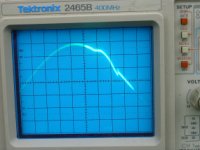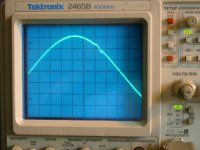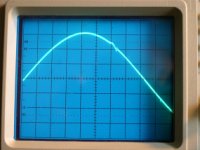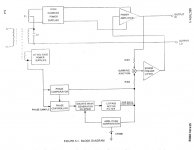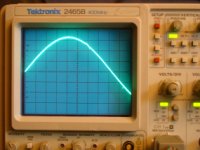The subject of capacitor burn-in generally elicits a fight between so-called subjectivists, who claim that capacitors sound better when broken in, and so-called (typically self-styled) scientific types, who claim the subjectivists are loonies and have no evidence for their claim. For my part, I consider subjective reports---and particularly subjective reports consistent across a wide base of subjects---evidence, but that's just the scientist in me, I suppose.
But j'digress. I've piped in on occasion in capacitor discussions to say I've *seen* the results of capacitor burn-in on my oscilloscope, that is, when I twice replaced capacitors in my trusty Elgar line conditioner .... to no effect, evidently, on the discussion. Well, a few days ago I took a stock such Elgar (a 6006B) and added a few teflon capacitors bypassing the large electrolytics in the amplifier power supply. Wouldn't you know, I got the very same spike on the output I did when I replaced capacitors on my other Elgar. Here's a picture of the output a few minutes after firing the unit up.
But j'digress. I've piped in on occasion in capacitor discussions to say I've *seen* the results of capacitor burn-in on my oscilloscope, that is, when I twice replaced capacitors in my trusty Elgar line conditioner .... to no effect, evidently, on the discussion. Well, a few days ago I took a stock such Elgar (a 6006B) and added a few teflon capacitors bypassing the large electrolytics in the amplifier power supply. Wouldn't you know, I got the very same spike on the output I did when I replaced capacitors on my other Elgar. Here's a picture of the output a few minutes after firing the unit up.
Attachments
Very interesting pictures. I'm in agreement with you in terms of empirical observations, the good scientist observes phenomena around him and then tries to explain it. The insecure deny that any such as yet unexplained phenomena can possibly exist.
I wonder what is actually going on at the material (quantum) level that might account for this. I have certainly heard the phenomena many times over the years in units that are constantly used with properly aged components where the only change was a single coupling capacitor. Often these components not only sound quite different than what they replaced, they seem to change, usually "improving" with a certain number of hours of use.
Not trusting my ears sometimes I will go and listen to someone elses system to "unlearn' my system's sound, if such a phenomena tends to exist. Better still of course is listening to live sound if available.
Edit: for clarity? LOL
I wonder what is actually going on at the material (quantum) level that might account for this. I have certainly heard the phenomena many times over the years in units that are constantly used with properly aged components where the only change was a single coupling capacitor. Often these components not only sound quite different than what they replaced, they seem to change, usually "improving" with a certain number of hours of use.
Not trusting my ears sometimes I will go and listen to someone elses system to "unlearn' my system's sound, if such a phenomena tends to exist. Better still of course is listening to live sound if available.
Edit: for clarity? LOL
Here's a picture of the Elgar topology. As you can see, a buck-boost amplifier sits atop the 120VAC transformer output. The capacitors bypass the supply electrolytics for this amplifier.
Here's a question. Why wouldn't the spike appearing in the pictures be removed by the reference sine feedback?
In any event, the amplitude of the spike is decreasing, which is the salient point for this discussion.
Kevin, I would suspect capacitor burn-in relates very probably to quantum changes in the dielectric. Alternatively, could be a neutralization of static charges on the surface of the dielectric.
Here's a question. Why wouldn't the spike appearing in the pictures be removed by the reference sine feedback?
In any event, the amplitude of the spike is decreasing, which is the salient point for this discussion.
Kevin, I would suspect capacitor burn-in relates very probably to quantum changes in the dielectric. Alternatively, could be a neutralization of static charges on the surface of the dielectric.
Attachments
You know, there are a lot of people who say they have been abducted and anally probed by aliens, say they talk to jesus and he talks back, and say they have sure-fire can't-miss methods to beat the odds in Vegas. Just because a bunch of people say similar things doesn't mean there is anything "scientific" in what they are saying.
For some reason the majority of people in the US voted W into office, not once, but twice! What does that tell you about the wisdom of the masses?
I_F
For some reason the majority of people in the US voted W into office, not once, but twice! What does that tell you about the wisdom of the masses?
I_F
I_Forgot said:Just because a bunch of people say similar things doesn't mean there is anything "scientific" in what they are saying.
People say this often.
Hey I_forgot, sort of the answer I'd expect from one of the characters on R.A.T, I for one have never made the claim that I was abducted by aliens, but then again you never know.. 
Still it wasn't a particularly useful dismissal, although it was actually quite humorous..
Now had you talked about parameter shifts in the error amplifier, or a reduction in cross-over distortion in the floating amplifier due to dropping vbe as the devices warmed up that would have added something to the discussion. (I bet class B output stage, its what I would probably do too.)
I think it is the province of the scientist to prove or debunk these suppositions, for example most people in the 19th century thought Darwin was cracked for espousing his theories, many of which find more than partial vindication in the modern science of genetics.
One of the ways to verify whether or not that spike is cross-over distortion in the output amplifier is to shut it off for a day, allow it to completely cool to room temperature and then repeat the experiment, if indeed the capacitor experienced a break in related parameter shift the spike should not reappear when the conditioner is repowered.
As for the other phenomena I am at a loss to explain, its easily understood in electrolytics, films are a bit more mysterious, I wonder about the effects of concentrated e fields on the dielectric, but honestly I'm just an engineer, not a materials scientist. Note that a lot of polymers do exhibit some electro-striction in the presence of strong electrostatic fields.
Capacitor dielectrics do have greatly differing DA (dielectric absorption and DF (dissipation factor) DA in a sense is the dielectric's ability to store energy in places other than the e field between the plates, I guess a bad analogy might be hysteresis, the energy being stored as a result of physical changes in the dielectric due to the field across it. DF is basically a loss factor, energy in heat out. These effects are both measurable and very audible as well.
I hear the so-called "break - in" phenomena and as a reasonable rational engineer I am disinclined to believe what I am hearing, but as an audiophool I do hear it. Not being a materials scientist I am at a loss to explain it, like Darwin I believe in the power of observation and deduction, and hope someone smarter than I will eventually provide a rational answer. In the mean time I'll continue to trust my powers of observation when confronted with the unexplained. Thankyou!

edit: fix typo
Still it wasn't a particularly useful dismissal, although it was actually quite humorous..
Now had you talked about parameter shifts in the error amplifier, or a reduction in cross-over distortion in the floating amplifier due to dropping vbe as the devices warmed up that would have added something to the discussion. (I bet class B output stage, its what I would probably do too.)
I think it is the province of the scientist to prove or debunk these suppositions, for example most people in the 19th century thought Darwin was cracked for espousing his theories, many of which find more than partial vindication in the modern science of genetics.
One of the ways to verify whether or not that spike is cross-over distortion in the output amplifier is to shut it off for a day, allow it to completely cool to room temperature and then repeat the experiment, if indeed the capacitor experienced a break in related parameter shift the spike should not reappear when the conditioner is repowered.
As for the other phenomena I am at a loss to explain, its easily understood in electrolytics, films are a bit more mysterious, I wonder about the effects of concentrated e fields on the dielectric, but honestly I'm just an engineer, not a materials scientist. Note that a lot of polymers do exhibit some electro-striction in the presence of strong electrostatic fields.
Capacitor dielectrics do have greatly differing DA (dielectric absorption and DF (dissipation factor) DA in a sense is the dielectric's ability to store energy in places other than the e field between the plates, I guess a bad analogy might be hysteresis, the energy being stored as a result of physical changes in the dielectric due to the field across it. DF is basically a loss factor, energy in heat out. These effects are both measurable and very audible as well.
I hear the so-called "break - in" phenomena and as a reasonable rational engineer I am disinclined to believe what I am hearing, but as an audiophool I do hear it. Not being a materials scientist I am at a loss to explain it, like Darwin I believe in the power of observation and deduction, and hope someone smarter than I will eventually provide a rational answer. In the mean time I'll continue to trust my powers of observation when confronted with the unexplained. Thankyou!
edit: fix typo
serengetiplains said:I would suspect capacitor burn-in relates very probably to quantum changes in the dielectric. Alternatively, could be a neutralization of static charges on the surface of the dielectric.
Once measured, the results should now be repeated (speaking scientifactorily of course
Cool. Burn-in makes a measurable difference in more than one place... I'll keep doing it then.
Kevin, neither the existence of the spike nor its amplitude and shape is a product of warmup: the spike appears as soon as the unit is powered up, with the same amplitude as when the unit was last shut off. For instance, I ran the unit for several hours after first installing the capacitors, during which time the amplitude of the spike decreased about 50%. During this time I had turned the unit off then on, briefly a few times. It always restarted with the same spike amplitude, or thereabouts, as when last turned off. I then turned the unit off during the evening after the first day of running it with the new capacitors, and left it off overnight. When I turned the unit back on the next morning, the spike was the same shape and amplitude as when I turned the unit off the previous night.
The reduction in amplitude seems therefore permanent (ie, chemical, or something).
The reduction in amplitude seems therefore permanent (ie, chemical, or something).
Let's see. Differences in the waveforms over time may just be differing noise on your power lines coming in. Did the refrigerator kick on? Maybe the elevator in your apartment building? Garbage in, garbage out, as it were...
As for spikes that are here now and gone later... was the power switch thrown at exactly the same phase angle on the power line waveform? If you happen to flip the switch near a zero crossing, you might not see a spike that you will see when you flip the switch when the voltage happens to peak.
I know it doesn't sound nearly as technical or romantic as capacitor burn-in, but either of these phenomena might be explained by your test leads failing to make a tight connection.
There are many possible explanations for what you see, capacitor burn-in is just one. With a test that has so many uncontrolled variables, I don't think it is possible to say exactly what is the cause of the variations you have seen.
I_F
As for spikes that are here now and gone later... was the power switch thrown at exactly the same phase angle on the power line waveform? If you happen to flip the switch near a zero crossing, you might not see a spike that you will see when you flip the switch when the voltage happens to peak.
I know it doesn't sound nearly as technical or romantic as capacitor burn-in, but either of these phenomena might be explained by your test leads failing to make a tight connection.
There are many possible explanations for what you see, capacitor burn-in is just one. With a test that has so many uncontrolled variables, I don't think it is possible to say exactly what is the cause of the variations you have seen.
I_F
Well, you've got something interesting to chase down. First thing I'd do is figure out what the cause is, without deciding in advance that it's the caps (or not the caps!). That will take a lot of probing around. Once the source of the change is identified, then it's worth trying to figure out a mechanism, but not before.
Just sayin', is all.
Just sayin', is all.
I changed the rectifier bridge from the old, heavy workhorse (circa. 1985) to a new, sprite FRED module. No change in the spike. I also swapped out the three circuit boards, exchanging them with those in my other Elgar, and no change.
That leaves: the wiring, the two banks of output transistors, and the transformer.
And the capacitors.
Here's today's visual.
That leaves: the wiring, the two banks of output transistors, and the transformer.
And the capacitors.
Here's today's visual.
Attachments
You know, there are a lot of people who say they have been abducted and anally probed by aliens, say they talk to jesus and he talks back, and say they have sure-fire can't-miss methods to beat the odds in Vegas. Just because a bunch of people say similar things doesn't mean there is anything "scientific" in what they are saying.
Two different types of people, the types you mention and those of us who listen carefully and often and can perceive differences in components and the process of break-in.
For some reason the majority of people in the US voted W into office, not once, but twice! What does that tell you about the wisdom of the masses?
They are reasonable people. He was obviously the better choice. Gore? Kerry?! Come on ....
John
- Status
- This old topic is closed. If you want to reopen this topic, contact a moderator using the "Report Post" button.
- Home
- Design & Build
- Parts
- Capacitor Burn-In/Break-In
